A mixed coating system with a zinc rich liquid base coat and a powder top coat, a mechanical pre-treatment process for controlled surface roughness, and a flexible plant designed by Eurotherm (Volpiano, Turin, Italy) in cooperation with Giletta’s technicians and the company’s advisor Fabio Balbo, owner of Tecniver: these are the technical choices made by Giletta Spa, a company of the Bucher Municipal Group, to meet two fundamental requirements for the production of its snow and ice removal machines: the qualitative one of corrosion resistance exceeding 2000 hours in salt spray tests and the operational one of a maximum of three weeks from order receipt to delivery of the finished machine.
Snow emergency: these two words are enough to conjure up imagery of snowploughs, salt spreaders, and salt and saline solutions sprayers, essential to restoring the road system in the event of a snowfall. The management of such a situation should be carefully planned in advance by municipalities and road and motorway operators so that it does not turn into a nightmare for users and citizens. We have gone from more frequent medium/low intensity snowfalls to infrequent but high intensity precipitations (similar to snow storms): therefore, the adoption of a sound winter emergency management plan is essential for the authorities in charge. This includes the necessary instrumentation for acquiring meteorological data and, in urban areas, along road and rail routes, and at airports, a fleet of machines for ice and snow removal consisting of vehicles of different types and sizes.
“We live in an era where precipitations are less and less frequent but also more intense and destructive. As a result, the suppliers of snow and ice management equipment must be highly responsive and able to deliver their machines within the short time frames customers require. We no longer operate in a market characterised by long-term planning. Today, we have to meet short-term demands and even be able to cope with unexpected orders for last-minute deliveries,” explains Fabrizio Abello, the plant manager of Bucher Municipal, a Group owning several long-established snow management and ice removal equipment brands, including Giletta Spa (Revello, Cuneo, Italy).
“We are the Group’s competence centre for the production of machines for winter road maintenance. The main characteristic of our production is its seasonality, with a peak from September to January. In addition, it is highly tied to the tenders of municipalities, public and private organisations managing roads, motorways, and transport infrastructure, which often require delivery times of three/four weeks from order receipt to shipping. Great responsiveness, plant flexibility, automation, and digitalisation are the factors that allow Giletta to serve this market with a just-in-time approach, with an attitude for managing sudden changes in planning and with a very short time-to-market.”
In its history, Giletta has made major investments to transform its production department into a perfectly efficient mechanism, the latest of which was the installation of a modern 4.0 coating plant designed and built by Eurotherm (Volpiano, Turin, Italy), a benchmark plant engineering company in the heavy vehicle sector.
Production organisation: a perfect mechanism
“Giletta Spa has always been the most innovative company in the field of snow removal and road deicing,” says Fabrizio Abello. “We invest over 2 million Euros a year in research and development, even in recent years when snow is falling less and less. We take much pride in this approach, enabling us to have such technological systems available that our machines are always one step ahead of those of our competitors. The Revello site’s core activity is the manufacture of salt spreaders and sprayers, but we also produce snowploughs, snow blowers, airport runway deicing equipment, and special equipment for various types of vehicles. Finally, we import the sweepers produced by our colleagues at Bucher Municipal. All the electronic controls of our machines are developed by a subsidiary, SAET srl – leader in custom electronics - to ensure the Group keeps its know-how in-house.
In recent years, due to the increasing demand for flexibility, customisation, and faster delivery times, a lot of work has been done to re-design our products with the aim of offering more and more modular machines. At the same time, we also reorganised our production flow. In 2019, we added a sheet metal machining department to our Revello production site, equipped with a fibre laser cutting machine, an automatic storage unit, and 3 last generation bending machines, in order to be independent and speed up our production cycle. We also increased our number of welding robots to 4; in 2024, the welding department will be further expanded. Of course, we also work with external suppliers because reaching such a high metalwork production capacity to supply all our product lines is nearly impossible. Our main strength is the ability to manage our workload to always meet delivery dates. Coating is the only production step we perform exclusively in-house for all our components: Giletta has always coated its parts in-house to retain total control over the process and meet the high quality standards required by machines intended for contact with aggressive agents.”
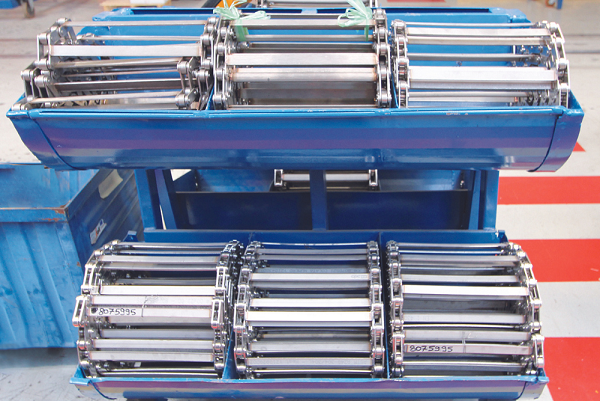 The metallic belt extraction system borrowed by Giletta from the agricultural machinery field is the key factor that determined the company’s success in this sector. ©ipcm
The metallic belt extraction system borrowed by Giletta from the agricultural machinery field is the key factor that determined the company’s success in this sector. ©ipcmA mixed, two-layer coating system for increased corrosion resistance
“For Giletta, coating has an aesthetic function focused on performances. Our first requirement is high corrosion resistance, over 2000 hours in salt spray tests, and this has affected all the technical and plant engineering choices relating to our coating process. Aesthetics are secondary,” illustrates Fabrizio Abello. “Before installing our new Eurotherm coating line, we used an automatic chain machine with the mechanical pre-treatment stage taking place in an automatic shot blasting machine for large parts from Carlo Banfi (now an OMSG Group’s company, Ed.), followed by a two-layer powder coating cycle applying an epoxy primer and a polyester top coat and a curing stage after the application of each layer. What motivated the investment in a new coating plant was a change in our finishing system, as we switched from a powder-on-powder to a mixed system with a liquid base coat and a powder top coat. We carried out numerous tests before moving on to this new system and we have obtained excellent results so far.
“The main reason why we decided to replace the powder base coat with a liquid one is that, although the former is very easy to apply and needs less trained operators to achieve good aesthetic results, it has less penetration than the latter, especially on components like ours that include many welded castings or complex-shaped surfaces. Secondly, with a view to increasing the corrosion resistance of our coated parts, we believe that the chemical formulation of a liquid product is more flexible and adaptable. Finally, opting for a mixed system has also made our production more sustainable, as we have eliminated a curing stage, thus lowering energy consumption and costs. Not to mention increased production speed: the liquid primer developed for Giletta by Sircolor (La Morra, Cuneo, Italy) has a water-based epoxy matrix with metallic zinc, only requiring a 10-minute flash-off phase at room temperature with forced ventilation before being overcoatable with the polyester powder top coat supplied by Pulverit (Milan, Italy). This translates into significant operational, economic, and time savings, especially considering that heating the high mass of the parts we coat on this line to 180-190°C requires considerable expenditure of energy.
“On the other hand, we have maintained the use of a powder top coat because it gives the surfaces a more robust, harder, and damage-resistant coating with better aesthetics, even if applied by less experienced operators. Today, with this coating cycle combined with mechanical shot blasting pre-treatment to clean the parts and reach a surface roughness of 30 microns for greater paint adhesion, we effortlessly exceed 2000 hours of salt spray resistance.”
Features of the new coating plant
Giletta turned to Eurotherm to develop a plant suitable for this new finishing cycle. “This project goes back a long way: we started with a market survey on possible suppliers in 2018-2019. Initially, we were thinking of an automatic in-line plant. However, the Covid pandemic slowed the project down, and when we took it up again, we realised that such a system would be difficult to manage, since our production is seasonal and alternates between peaks and substantial slowdown. Giving it the right size to meet our high-season needs would have meant leaving it almost idle in the low season. This is why the concept that convinced us most was the box design presented by Eurotherm. In the same period, we also began assessing a possible switch to a mixed coating system.”
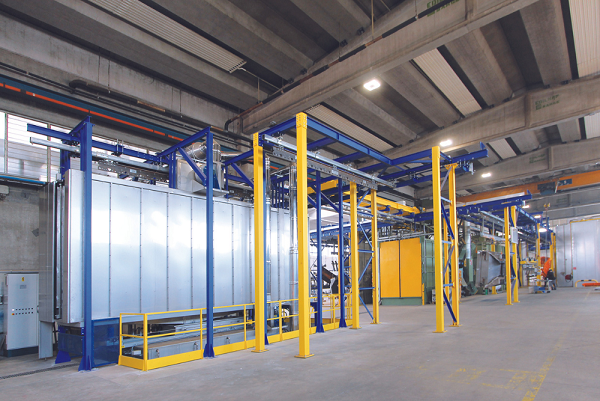 Front view of the Eurotherm coating plant installed at Giletta’s premises. ©ipcm
Front view of the Eurotherm coating plant installed at Giletta’s premises. ©ipcm“We provided Giletta with a manual coating system to replace its old step-by-step in-line plant,” says Rocco D’Aloia, project manager at Eurotherm. “Among other requirements, the new machine had to double the previous production rate while increasing management flexibility and energy savings. We achieved all these goals: the company moved from working on two shifts, including Saturdays, to one shift for processing the same quantity of coated parts, with significant gas and electricity savings compared with the old in-line plant. Apart from some components that are pickled, most of Giletta’s production is coated.
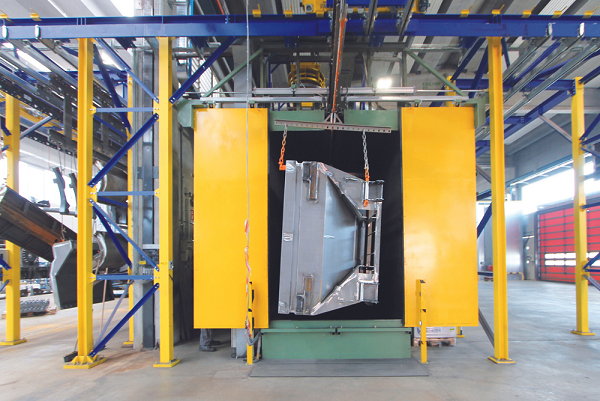 A container inside the Carlo Banfi automatic shot blasting machine. ©ipcm
A container inside the Carlo Banfi automatic shot blasting machine. ©ipcmThe company prefers mechanical pre-treatment: all small to medium-sized parts are shot blasted in a cluster machine, except for the containers, treated in the already existing Carlo Banfi shot blaster, which we revamped in terms of both software and mechanical aspects to lengthen it and connect it to the blowing station shared by the two systems, which can work simultaneously. The automatic cell pre-treatment tunnel is used to clean all parts, such as hydraulic cylinders and gearboxes, that cannot be sandblasted. Although integrated with the rest of the line, the cleaning cell is now used for treating other components that are coated off-line.”
Giletta’s current production cycle is as follows:
1. Sandblasting with metal grit or 3-stage pre-treatment (ready for 5)
2. Liquid zinc coating followed by booth drying at 25 °C
3. Powder coating
4. Curing.
The machines installed by Eurotherm were as follows:
- 1 3-stage cleaning cell
- 2 vertical-flow pressurised liquid coating booths with an air handling unit for heating and drying at 70 °C, with a size of 4x9 m
- 2 vertical-flow powder coating booths, of which one is equipped with a cyclone for colour recovery, with a size of 4x9 m
- 3 curing ovens with temperatures up to 250 °C
- 3 semi-automatic transfer carts
- 2 lifting stations for loading/unloading
- overhead conveyor
- 1 climate-controlled paint storage module
- 1 existing Carlo Banfi in-line sandblasting machine, revamped with 4.0 digital software and connected to the manual blowing station
- 1 OMSG cluster shot blasting machine with maximum workpiece dimensions of ø 2500 x 3000 H mm.
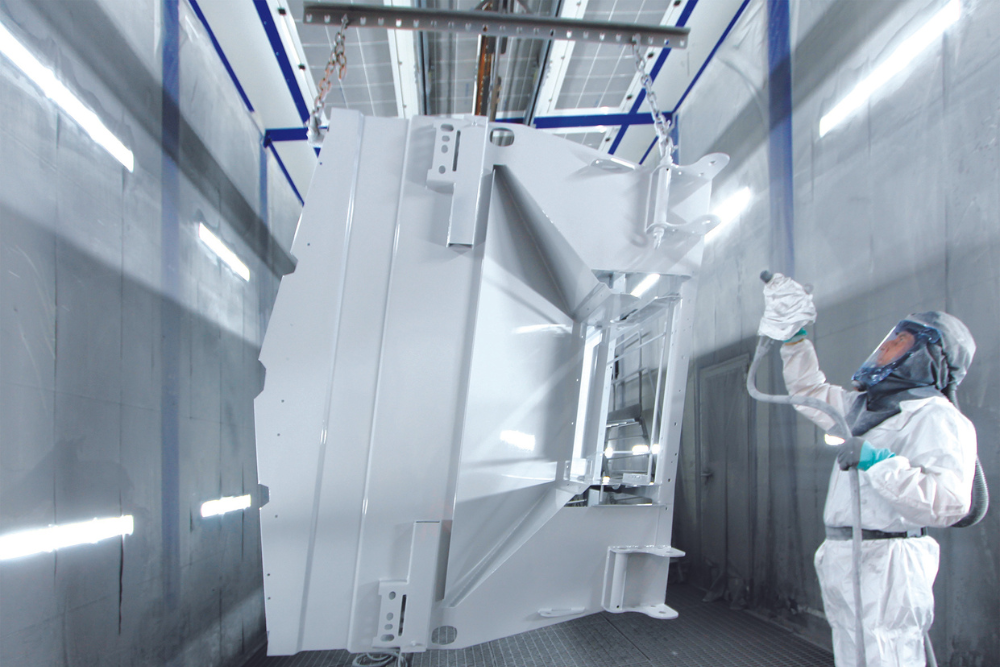 Liquid base coat application in one of the two vertical-flow pressurised booths. ©ipcm
Liquid base coat application in one of the two vertical-flow pressurised booths. ©ipcm 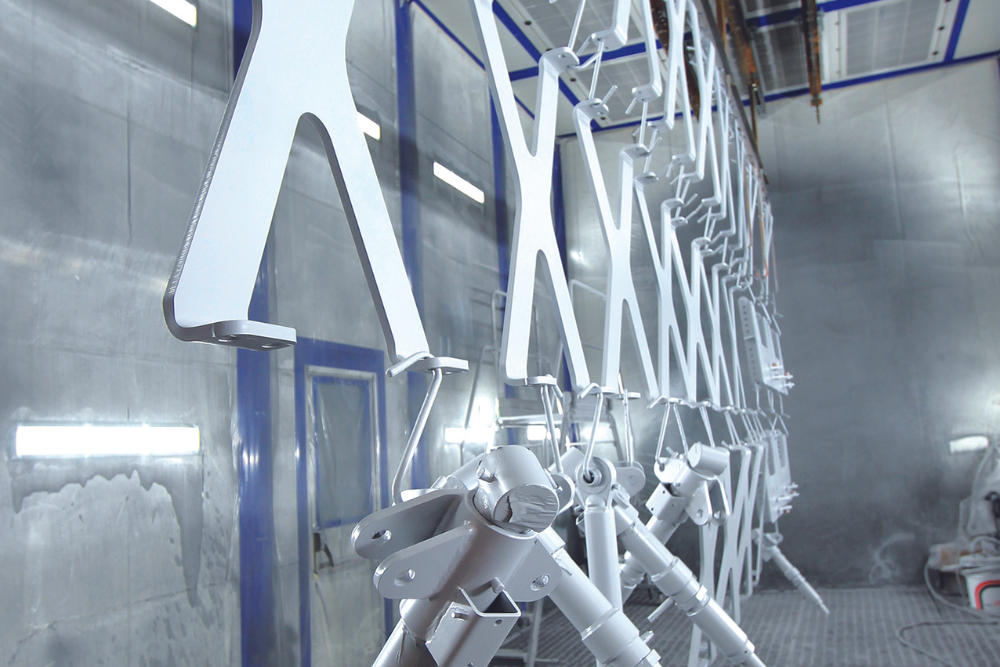 Powder top coat application in one of the two dedicated booths. ©ipcm
Powder top coat application in one of the two dedicated booths. ©ipcm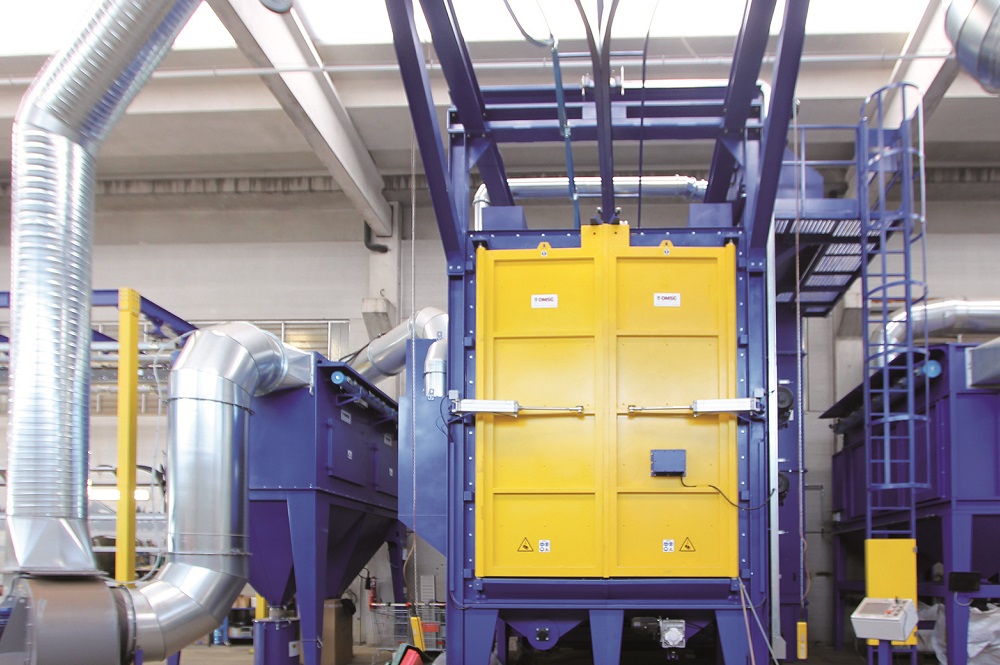 The OMSG automatic cluster shot blasting machine with two hoists. ©ipcm
The OMSG automatic cluster shot blasting machine with two hoists. ©ipcm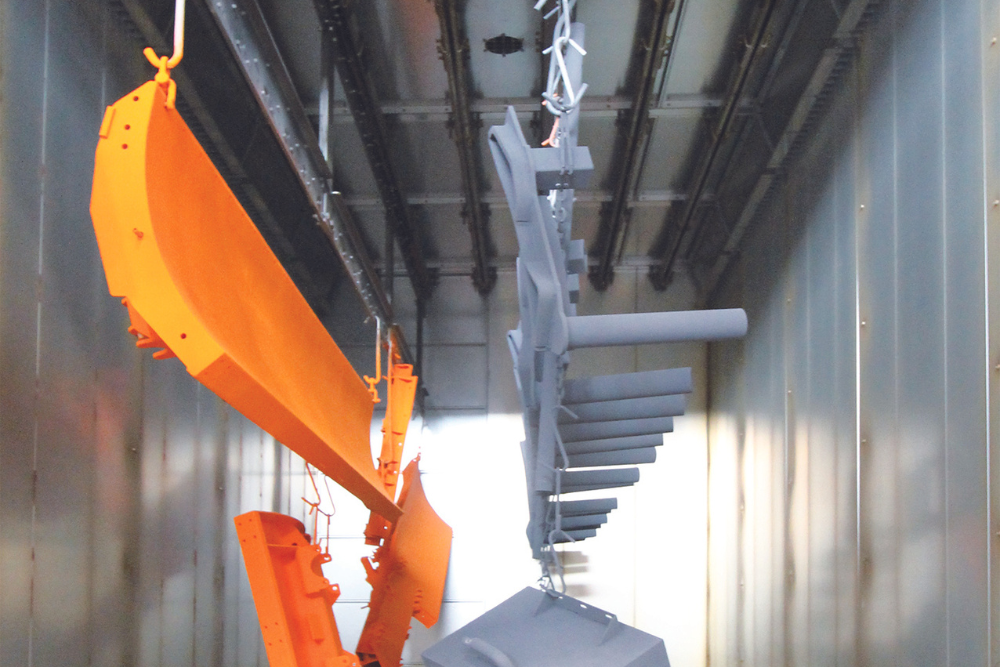 Coated parts inside one of the ovens. ©ipcm
Coated parts inside one of the ovens. ©ipcmThe latter machine has a Y-shaped handling system with two hoists, each with a load capacity of 2000 kg. When one hoist is inside the machine for the shot blasting phase, the other is outside for loading/unloading parts, thus reducing idle times of the machine. The machine has four 15-kW turbines with special alloy components in K110. It meets the Industry 4.0 parameters and is equipped with an inverter to adjust the kinetic energy of the abrasive projected by the centrifugal turbines, thus avoiding possible damage and deformation of thin metal parts.
The maximum hanging capacity of the coating system is 2200 kg, with a maximum length of 7.5 m. The powder top coat is applied with a state-of-the-art manual unit from Zeus Electrostatic System; the liquid base coat is applied with manual electrostatic units from Wagner, fed by an Intellimix mixer installed in a separate compartment.
“The plant’s lifting devices facilitate the operators’ work in loading and unloading heavy parts,” adds Rocco D’Aloia. “After the hanging operation, the first transfer cart enters the sandblasting machine, equipped with a one-rail ring. At the exit, the parts pass through a manual blowing station for cleaning. A second transfer cart takes them to the masking station, if required, or directly to the base coat application booths, applying the same light grey liquid paint on all components. The same cart transfers the workpieces to the coloured powder top coat application booths and, afterwards, to the curing ovens. Finally, a third cart takes them to the unloading area with the second lifting device. The powder coating booth devoted to the RAL 2011 orange, our company colour, is equipped with a paint recovery system, whereas the one applying all other tints requested by customers (mainly gray, white, yellow, and red) is not.”
Speed, flexibility, and independence of treatment phases: a goal successfully achieved
“Eurotherm’s box concept with four booths and three curing ovens gave us a degree of flexibility and speed that an automatic in-line system could never provide,” emphasises Fabrizio Abello from Giletta Spa. “Depending on output demand, we decide whether to use one or more ovens, whereas having two booths available for both base coat and colour application enables us to use them two by two or all four at the same time during production peaks: in some periods, we use one or two booths per day, whereas if necessary we can paint with the four booths operating simultaneously. Our goal was to implement a highly technological but at the same time flexible system: Eurotherm has fully met this requirement.”